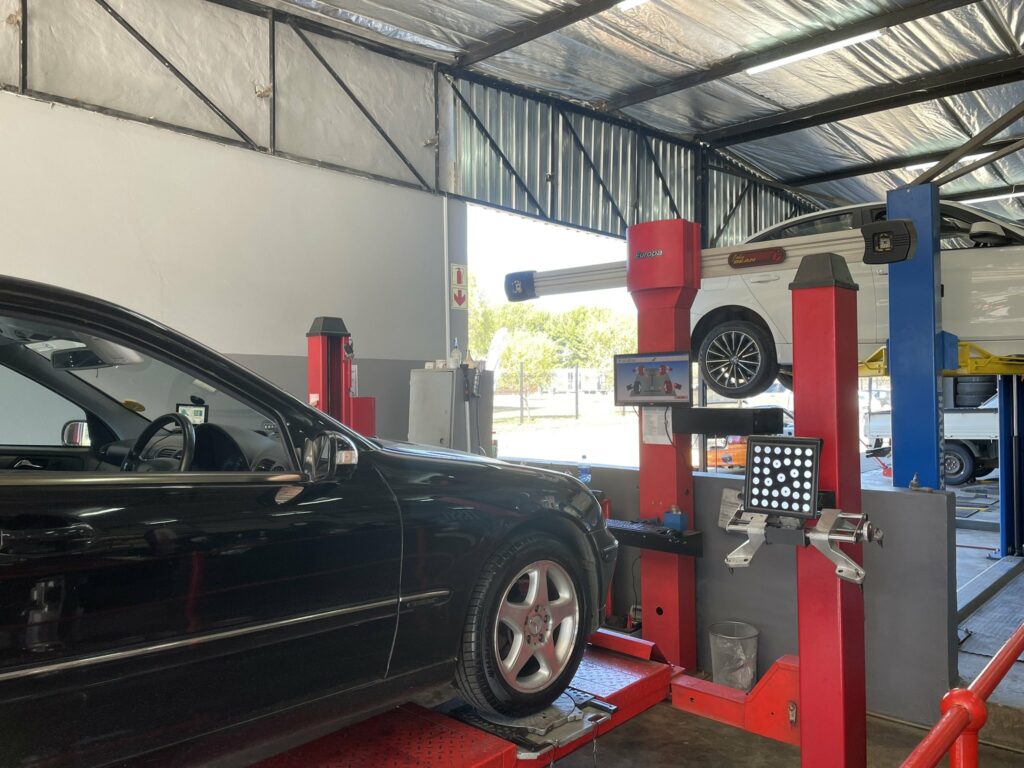Wheel Alignment plays an important role regarding South African motorists’ road safety. Let’s explore why. While various factors contribute to overall safety, one critical aspect that often escapes notice is wheel alignment. Proper wheel alignment is a pivotal factor in ensuring a vehicle’s safety, safeguarding its occupants and fellow road users. 1
Understanding Wheel Alignment
What is wheel alignment? Wheel alignment is the process of adjusting the angles of a vehicle’s wheels to ensure they are parallel to one another and perpendicular to the ground. This process is crucial for maintaining optimal vehicle performance and tyre longevity. 1
What Causes Wheel Misalignment?
Over time, factors like potholes and general road conditions can lead to misalignment, resulting in uneven tire wear, decreased fuel efficiency, and compromised drivability. During a wheel alignment, specialized equipment is used to measure and adjust the wheel angles in accordance with the manufacturer’s specifications. This process ensures that all four wheels are correctly aligned, promoting a smooth and safe driving experience while maximizing tire lifespan. Regular wheel alignments are recommended to uphold optimal vehicle performance and prevent potential issues down the road. 1
Common Signs of Poor Wheel Alignment to Look Out for Every Day?
- Uneven tire wear
- Vehicle veering to one side
- Steering wheel vibrations
- Difficulty in steering
- Reduced fuel efficiency
- Unusual tire noises
- Changes in handling following encounters with curbs or potholes1
The Advantages of Routine Wheel Alignments
Extended Tire Life
Regular wheel alignments promote even tire wear, leading to extended tire longevity. Proper alignment reduces undue tire stress and premature wear, saving money on frequent tire replacements. 1
Enhanced Fuel Efficiency
Properly aligned wheels reduce rolling resistance, enhancing fuel efficiency. This means you can cover more miles on the same amount of fuel, reducing trips to the pump. 1
Improved Vehicle Handling and Safety
Correct wheel alignment fosters optimal vehicle handling and stability. It helps maintain proper traction and control, especially during cornering and braking, reducing the risk of accidents and enhancing overall road safety. 1
Enhanced Driver Comfort
Misaligned wheels can cause steering wheel vibrations and an uncomfortable driving experience. Regular alignments ensure your vehicle runs smoothly, providing a more comfortable and enjoyable drive. 1
Cost Savings
By preventing uneven tire wear and reducing the risk of premature tire replacement, regular wheel alignment translates into long-term cost savings. Additionally, improved fuel efficiency means reduced overall vehicle operation and maintenance expenses. 1
Preventive Maintenance
Routine wheel alignment serves as a form of preventive maintenance, identifying and rectifying alignment issues before they escalate. By addressing misalignment early, potential damage to other suspension system components can be averted. 1
Manufacturer’s Warranty
Some vehicle manufacturers include wheel alignment in their recommended maintenance schedules. Adhering to these guidelines ensures warranty validity and coverage for potential alignment issues. 1
So, wheel alignment is a fundamental aspect of vehicle maintenance. Don’t wait until issues arise; prioritize your safety and the longevity of your vehicle. 1
Disclaimer
This article is about wheel alignment and road safety.1
Now you know more how to take care of your vehicle’s wheels. But how are you taking care of your car regarding car insurance?
Are you considering changing your car insurance or buying car insurance for the first time? Choose affordable car insurance with unique benefits like fixed premiums* and a reducing excess*. T’s and C’s apply.
Please get professional financial advice from a certified financial advisor to ensure you select the appropriate financial services product. 1
This article was prepared by Eric Sandmann in his personal capacity. The views and opinions expressed in this article are the author’s own. The views and opinions in the article should not be attributed to anyone but the author unless expressly stated. Nothing in this article should be relied upon as advice, this publication is presented for informational purposes only. No person should act or refrain from acting in reliance on any information found in this article, without first obtaining proper financial advice from the appropriate professional.
